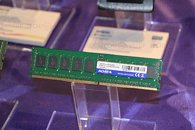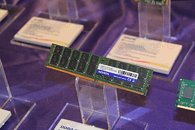Thursday, January 9th 2014

ADATA Shows Off DDR4 Modules at CES
Taiwanese company ADATA Technology is gearing up for the arrival of DDR4 and at CES it showcased a couple of memory modules based on the standard. ADATA's DDR4 sticks have 8 GB and 16 GB capacities and run at 2133 MHz with CL15 latencies while powered at 1.2V.
The modules on display are 'suitable for servers' (they are R-DIMMs) but the company will surely have some consumer-oriented offerings for later this year when Intel launches the DDR4-supporting Haswell-E processors.
The modules on display are 'suitable for servers' (they are R-DIMMs) but the company will surely have some consumer-oriented offerings for later this year when Intel launches the DDR4-supporting Haswell-E processors.


23 Comments on ADATA Shows Off DDR4 Modules at CES
Come back when you got something solid, ADATA.
The latency is 12% worse than a 1600mhz CL10 dimm that nobody seems to complain about, with throughput improved by 33%, all on 1.2v.
That is damn good for a first-gen DDR4 offering. Don't forget that DDR3 wasn't much better than DDR2 to start.
DDR4 is being hyped because PC sales are so bad that memory makers are not selling much DDR3. With DDR4 which is a totally different topology, you must buy all of the DDR4 RAM you desire in one purchase. There is no "adding of RAM" like with prior DDR memory. If you decide you want more DDR4 RAM then you scap what you have and pay again for a larger quantity of DDR4 RAM - and you get vertually nothing in system performance for the price. This is a desperation move because the PC industry like most industries is suffering from the 6+ year economic meltdown in Asia, the U.S. and Europe.
The same happened with DDR3 when they first launched, the DDR2-1066 or better were smoking them. Now a DDR3-2133 is exactly double the performance of the DDR2-1066. Same will happen with DDR4 when it will get improved freqs, 4Ghz or more. Just patience people.
And I remember it happened with DDR2 too that was slower than DDR(1) at launch...
In any event the power savings in servers will be what drives initial DDR4 adoption.